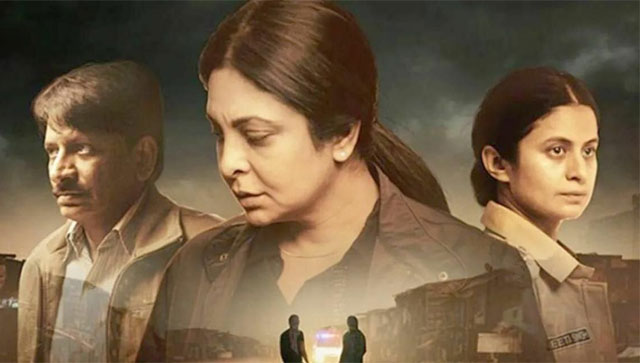Delhi Crime Season 2 has managed to pull a difficult feat at a tumultuous time for entertainment in India. It has focused on a delicate issue- that of class divide- while touching upon complex subjects like deep set prejudice against tribes and marginalized communities without getting heckled on social media (beyond a point). Given that the series is helmed by US based showrunner and director Tanuj Chopra, it’s balanced narrative also tackles gender intelligently. On both sides of the battle here are women, without the justification of a moral high ground or compelling circumstances.
This season has taken four years to return to the screen. This time around there is no black and white victims or perpetrators. There is a back story for everyone. Putting together a narrative that is a socio-economic comment and not just a crime drama, the series leaves the viewer to think about what makes for a crime.
In 2019, this show was reported to have been based on the infamous Nithari Kand. This village located near a posh suburb in Noida within the National Capital Region (NCR) witnessed a dastardly series of murders of multiple people from poor families. Most victims were young girls. Skeletons were found in Moninder Singh Pandher’s house, a rich resident.
At that point Netflix never commented and Richie Mehta, who had initially envisaged Delhi Crime as a limited series, had moved on to a different story. For season 2, he handed over his notes on police interviews and conversations with Neeraj Kumar, Delhi’s top cop to the makers of the show. Beyond that the creative team on board this series is new.
Drawing from a series of heinous crimes that Neeraj Kumar had tackled, as narrated in his book chapter Moongazer (from the book Khaki Files), season 2 contemporizes the bludgeon killings committed by the infamous Kaccha Baniyan or Chaddi Baniyan gang in the Nineties. These criminals had terrorized neighborhoods across Delhi, leading to a sense of distrust against the poor that worked as labour. In this contemporary set up, mobile phones and technology play a key role in police procedure. And the differences- between haves and have nots- are starker. The victims are senior citizens living in posh South Delhi neighborhoods. From bludgeoning people to death, to eating their food and drinking their booze and dirtying their homes, these crimes were a slap on the face of affluence, visibly on display in Delhi NCR.
But the best part of adapting this season to reality-based fiction has been its antagonist. She is a woman. The protagonist is DCP Vertika Chaturvedi (Shefali Shah) supported by her able team. It includes the young IPS officer Neeti Singh (Rasika Dugal) who is struggling to find work life balance. Now they are chasing a murderer who is smart, prepared and slippery without the oil used by the criminal gang from Delhi’s past. Tillotama Shome delivers a chilling performance as a woman who scouts potential rich victims and robs them, gets them killed mercilessly, simply to get money and seek the life of a ‘malik’ (owner). She wants to start her own beauty parlour in a super-rich neighborhood. She is so focused on her desires that she leaves behind a child and husband to pursue a life of crime. In a scene she applies an expensive face cream, that she has lifted from her first victim off her bedside table. That moment captures the contradictions between lives of the rich and poor, the haves and have nots, that can lead to choices beyond logic and reason in people.
To build its characters, both actors and writers have carried out extensive research and detailing. Rasika Dugal shadowed a police recruit to understand how she functions. Tanuj Chopra, who led the writers’ room, explains that besides police officers who were involved in capturing the Kaccha Baniyan gang, they reached out to theatre groups representing marginalized communities and academics to build an accurate social fabric of the city. For Chopra the series comes from a personal point of view. He recalls,” My grandparents lived there during the Nineties…These crimes had taken center stage then. As a teenager, and during my childhood, I have lived in Delhi from time to time. In my 20s, I would visit my cousins. It is a very challenging city- one that has so much beauty and so much pollution. You see so many contradictions. So the theme (of the series) resonated with me. I grew up with the city. In some ways, this season is my love letter to Delhi. “
A woman choosing to commit a crime for greed and not need, makes for an interesting interpretation. Unlike, say in the Tamil film, Saani Kaayidham starring Keethy Suresh and Selvaraghavan where a rape victim who has lost her child and husband to gory caste violence, goes after blood and flesh, the murderer in Delhi Crime is seeking a good life and shunning her preset place in a class and income driven social structure.
Curiously the show’s writers have not been heard from. And its reference to the prejudice against an entire tribe from the police is used as a tool to justify ‘Vartika’ (played by Shefali Shah) faltering. It doesn’t go beyond a skin deep reference. Still, in the current censorious environment, this series achieves a difficult feat of highlighting structural social problems. Which is a win.
Archita Kashyap is an experienced journalist and writer on film, music, and pop culture. She has handled entertainment content for broadcast news and digital platforms over 15 years.
Read all the Latest News, Trending News, Cricket News, Bollywood News, India News and Entertainment News here. Follow us on Facebook, Twitter and Instagram.

